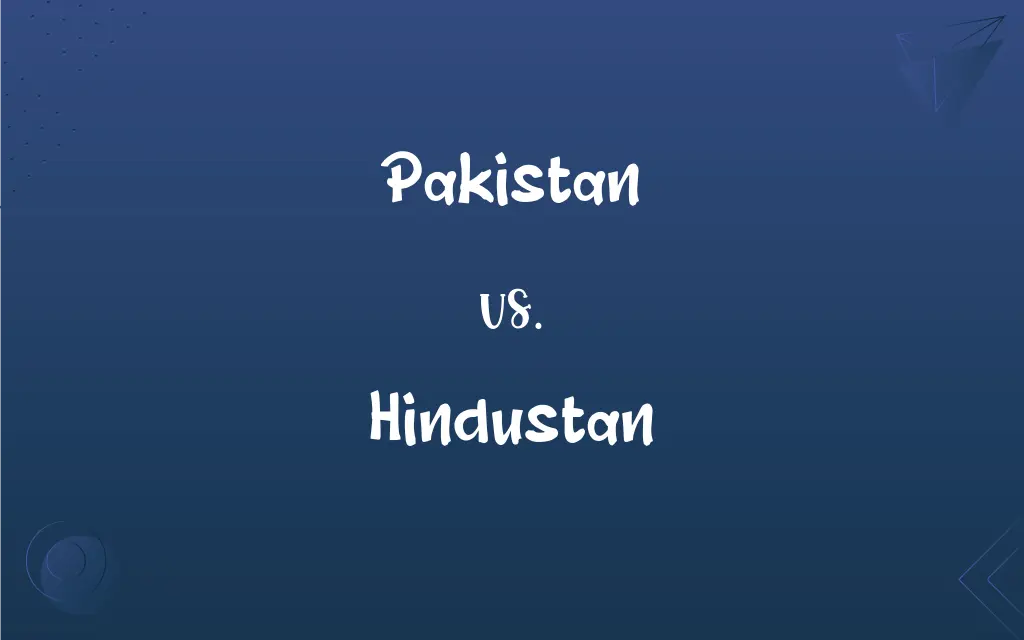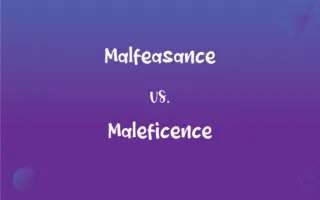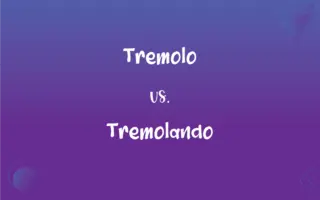Pakistan vs. Hindustan: What's the Difference?
By Aimie Carlson || Updated on May 30, 2024
"Pakistan" is a modern nation-state founded in 1947, while "Hindustan" historically refers to the northern region of the Indian subcontinent. Both terms relate to South Asia but differ in contemporary usage and historical context.

Key Differences
"Pakistan" is a country in South Asia established in 1947 after gaining independence from British rule. It was created as a separate nation for Muslims in the region and consists of four provinces: Punjab, Sindh, Khyber Pakhtunkhwa, and Balochistan. "Hindustan," on the other hand, is an ancient and historical term that has been used to refer to the northern part of the Indian subcontinent, particularly during the Mughal Empire. The term is derived from the Persian word for "land of the Hindus" and historically encompassed parts of modern-day India, Pakistan, and Bangladesh.
While "Pakistan" is a specific modern political entity with defined borders, "Hindustan" has evolved in its usage over time. Today, "Hindustan" is sometimes used informally to refer to India, though it historically included broader territories.
The creation of Pakistan was driven by the desire for a Muslim-majority state, whereas "Hindustan" was a more inclusive term used during different periods to describe a region with diverse religious and cultural identities.
Pakistan's formation led to significant geopolitical changes in South Asia, including the partition of British India. Hindustan, however, was a term used throughout different eras, including during the reigns of various empires and kingdoms.
"Pakistan" today has a defined government, flag, and national identity, whereas "Hindustan" lacks these modern political characteristics, existing more as a historical or cultural reference.
ADVERTISEMENT
Comparison Chart
Definition
Modern nation-state founded in 1947
Historical term for northern Indian subcontinent
Contemporary Usage
Specific country
Informally used to refer to India, historically broader
Historical Context
Created for Muslims in South Asia
Used during various empires, especially Mughal
Geopolitical Changes
Led to partition of British India
Term used across different historical periods
Modern Characteristics
Defined borders, government, national identity
Lacks modern political characteristics, more cultural/historical
ADVERTISEMENT
Pakistan and Hindustan Definitions
Pakistan
A member of the United Nations.
Pakistan participates in various UN peacekeeping missions.
Hindustan
Historical term for northern Indian subcontinent.
During the Mughal era, Hindustan was a cultural and political hub.
Pakistan
Located to the northwest of India.
Pakistan shares a border with India and Afghanistan.
Hindustan
Sometimes refers to modern India.
Some people still refer to India as Hindustan.
Pakistan
A Muslim-majority nation.
Pakistan was created to provide a separate homeland for Muslims.
Hindustan
Encompassed parts of modern India, Pakistan, and Bangladesh.
Historically, Hindustan included regions that are now separate countries.
Pakistan
Comprising four provinces.
Pakistan's provinces include Punjab and Sindh.
Hindustan
Derived from Persian, meaning "land of the Hindus."
Hindustan has been a term used by Persian-speaking conquerors.
Pakistan
A country in South Asia founded in 1947.
Pakistan celebrated its Independence Day on August 14.
Hindustan
Associated with the Mughal Empire.
The Mughal rulers of Hindustan left a lasting architectural legacy.
Pakistan
A country in South Asia formerly part of British India.
Hindustan
Northern region of India where Hinduism predominates.
Pakistan
A Muslim republic that occupies the heartland of ancient south Asian civilization in the Indus River valley; formerly part of India; achieved independence from the United Kingdom in 1947
Hindustan
Northern region of India where Hinduism predominates
FAQs
What is Hindustan?
Hindustan is a historical term referring to the northern part of the Indian subcontinent.
When was Pakistan founded?
Pakistan was founded on August 14, 1947.
Is Hindustan a country?
No, Hindustan is a historical and cultural term, not a modern country.
Why was Pakistan created?
Pakistan was created to provide a separate homeland for Muslims in South Asia.
Does Hindustan refer to modern India?
Informally, yes, but historically it referred to a broader region.
Is Hindustan still used today?
It is used informally to refer to India but not in an official capacity.
Which empires used the term Hindustan?
Primarily the Mughal Empire, among others.
What is the significance of August 14 for Pakistan?
It is the day Pakistan gained independence from British rule.
Does Hindustan have a government?
No, it is a historical term and does not have a government.
What are the provinces of Pakistan?
Punjab, Sindh, Khyber Pakhtunkhwa, and Balochistan.
How did the creation of Pakistan affect South Asia?
It led to the partition of British India and significant geopolitical changes.
What is Pakistan?
Pakistan is a country in South Asia established in 1947.
What is the origin of the term Hindustan?
It comes from the Persian word meaning "land of the Hindus."
What cultural significance does Hindustan hold?
It represents a rich history of various empires and cultures in northern India.
What languages are spoken in Hindustan?
Historically, Persian and local languages; now, mainly Hindi and Urdu.
What are some landmarks in Pakistan?
The Badshahi Mosque and the Lahore Fort.
What are some landmarks in Hindustan?
The Taj Mahal and the Red Fort.
What religions are practiced in Pakistan?
Primarily Islam.
Is Pakistan a member of the United Nations?
Yes, Pakistan is a UN member.
What does Hindustan encompass historically?
Parts of modern India, Pakistan, and Bangladesh.
About Author
Written by
Aimie CarlsonAimie Carlson, holding a master's degree in English literature, is a fervent English language enthusiast. She lends her writing talents to Difference Wiki, a prominent website that specializes in comparisons, offering readers insightful analyses that both captivate and inform.
































































